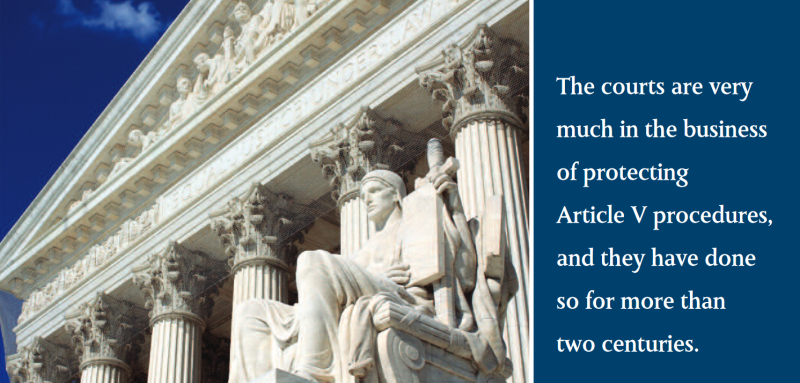Article 6 - How the Courts have clarified the Constitution’s Amendment Process
How the Courts have Clarified the Constitution’s Amendment Process
Robert Natelson, Independence Institute’s Senior Fellow in Constitutional Jurisprudence and Head of the Institute’s Article V Information Center
One source of security we have in using the Constitution’s amendment process is the courts’ (including the U.S. Supreme Court) long history of protecting the integrity of the procedure.
Many of those who pontificate on the subject are largely unaware of this jurisprudence. As a result, they often debate questions that the courts have long resolved or promote scenarios (such as the “runaway” scenario) that the law has long foreclosed.
Here are some of the key issues the courts have addressed, either in binding judgments or in what lawyers call “persuasive authority.” This listing of cases is only partial.
- Article V grants enumerated powers to named assemblies—that is, to Congress, state legislatures, conventions for proposing amendments, and state conventions. When an assembly acts under Article V, that assembly executes a “federal function” different from whatever other responsibilities it may have. Hawke v. Smith, 253U.S.221 (1920); Leser v. Garnett, 258 U.S. 130 (1922); State ex rel. Donnelly v. Myers, 127Ohio St.104, 186 N.E. 918 (1933); Dyer v. Blair,390 F. Supp. 1291 (N.D. Ill. 1975) (Justice Stevens).
- Article V gives authority to named assemblies, without participation by the executive. Hollingsworth v. Virginia, 3 U.S. (3 Dall.) 378 (1798).
- Where the language of Article V is clear, it must be enforced as written. UnitedStates v. Sprague, 282U.S.716 (1931).
- That does not mean, as some have claimed, that judges may never go beyond reading the words and guessing what they signify. Rather, a court may consider the history underlying Article V. Dyer v. Blair, 390F. Supp.1291(N.D. Ill.1975) (Justice Stevens). It may also consider what is implied as well as what is expressed. Dillon v. Gloss,256 U.S. 368 (1921). In other words, courts apply the same rules of interpretation to Article V as elsewhere.
- Just as other enumerated powers in the Constitution bring with them certain incidental authority, so also do the powers enumerated in Article V. State ex rel.Donnelly v. Myers, 127Ohio St.104, 186N.E. 918 (1933). This point and the one previous are important in determining the scope of such Article V words as “call,” “convention,” and “application.”
- The two - thirds vote required in Congress for proposing amendments is two thirds of a quorum present and voting, not of the entire membership. State of Rhode Island v. Palmer, 253 U.S. 320 (1920).
- A convention for proposing amendments is, like all of its predecessors, a “convention of the states.” Smith v. UnionBank, 30 U.S. 518, 528 (1831). The national government is not concerned with how Article V conventions or state legislatures are constituted. United States v.Thibault,47 F.2d169(2d Cir.1931).
- No legislature or convention has power to alter the ratification procedure. That is fixed by Article V. Hawke v. Smith,253U.S. 221 (1920);United States v. Sprague, 282 U.S. 716 (1931). Some “runaway”alarmists have suggested that a convention for proposing amendments could decree ratification by national referendum, but the Supreme Court has ruled this out. Dodgev. Woolsey,59 U.S. 331 (1855). Neithercan a state mutate its own ratifying procedure into a referendum. State of RhodeIsland v. Palmer, 253 U.S. 320 (1920).
- Congress may not try to manipulate the ratification procedure, other than by choosing one of two specified “modes of ratification.” Idaho v. Freeman,529 F. Supp. 1107 (D. Idaho 1981), a judgment vacated as moot by Carmen v. Idaho, 459 U.S. 809 (1982); compareUnited Statesv. Sprague, 282 U.S. 716 (1931).
- A convention meeting under Article V may be limited to its purpose. In ReOpinion of the Justices, 204 N.C. 306, 172 S.E. 474 (1933).
- But an outside body may not dictate an Article V assembly’s rules and procedures. Leser v. Garnett, 258 U.S. 130 (1922); Dyer v. Blair, 390F. Supp.1291(N.D. Ill.1975) (Justice Stevens).
- Nor may the assembly be compelled to resolve the issue presented to it in a particular way. State ex rel. Harper v. Waltermire,691P.2d826(1984); AFL-CIO v. Eu, 686P.2d609(Cal.1984); Miller v. Moore, 169F.3d1119(8th Cir.1999); Gralike v. Cook, 191F.3d911, 924-25 (8thCir. 1999), affirmed on other grounds sub nom. Cook v. Gralike,531 U.S. 510 (2001); Barker v. Hazeltine, 3F. Supp. 2d1088,1094 (D.S.D. 1998);League of Women Voters of Maine v. Gwadosky,966F. Supp.52 (D. Me. 1997);Donovan v. Priest, 931 S.W.2d 119 (Ark. 1996).
- Article V functions are complete when a convention or legislature has acted. There is no need for other officials to pro-claim the action. United States ex rel. Widenmann v. Colby, 265 F.398(D.C. Cir. 1920), affirmed 257 U.S. 619 (1921).
As these cases illustrate, the courts are very much in the business of protecting Article V procedures, and they have done so for more than two centuries.
![One source of security we have... is the courts’ long history of protecting the integrity of the [amendment] procedure. One source of security we have... is the courts’ long history of protecting the integrity of the [amendment] procedure.](/lib/exe/fetch.php?w=800&tok=7c2192&media=documents:cosproject:surge:surge-6-1.png)

